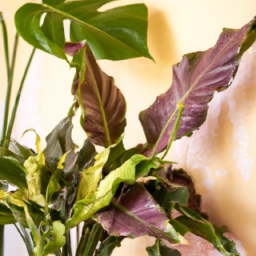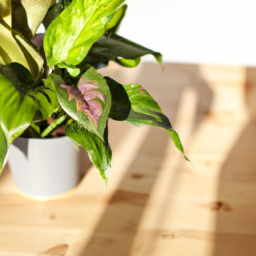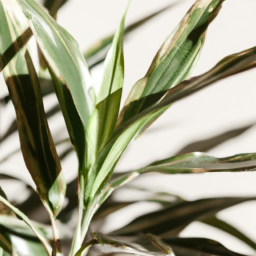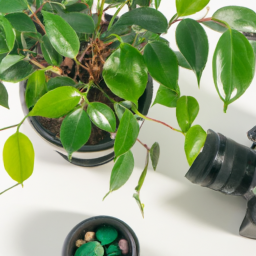
When did indoor plants become popular? It seems like everywhere you look these days, there are lush green plants adorning homes, offices, and even restaurants. From tiny succulents to towering fiddle leaf fig trees, indoor plants have become a staple in interior design and a must-have for those looking to add a touch of nature to their spaces. But how did this trend come about? In this blog post, we’ll explore the history of indoor plants and delve into the factors that contributed to their rise in popularity. So, grab a cup of tea and join us on this journey through time to uncover the origins of the indoor plant craze.
The History of Indoor Plants: Tracing the Origins of Their Popularity
Indoor plants have become an integral part of our lives, bringing a touch of nature into our homes and workplaces. But have you ever wondered when and how indoor plants became so popular? In this article, we will take a journey through time to explore the fascinating history of indoor plants and uncover the origins of their widespread popularity.
The Early Beginnings: Ancient Civilizations and Indoor Gardens
Believe it or not, the concept of indoor plants dates back thousands of years. Ancient civilizations, such as the Egyptians, Greeks, and Romans, were known to cultivate plants indoors for various purposes. These early indoor gardens were often associated with wealth, power, and religious beliefs.
The Egyptians, for instance, created elaborate indoor gardens in their palaces and temples, using plants like palms and papyrus. These gardens served both aesthetic and practical purposes, providing shade, fragrance, and a serene environment for relaxation and meditation.
Similarly, the Greeks and Romans incorporated indoor plants into their architecture, designing magnificent atriums and courtyards filled with lush greenery. These indoor gardens were considered symbols of luxury and status, reflecting the wealth and sophistication of their owners.
The Victorian Era: A Flourishing Obsession with Indoor Plants
While indoor gardening remained popular throughout history, it was during the Victorian era that indoor plants truly flourished. The Victorian period, spanning from the late 19th century to the early 20th century, witnessed a surge of interest in botany and horticulture.
With the rise of the British Empire, explorers and botanists brought back exotic plants from distant lands, captivating the imaginations of the Victorians. These newly discovered plant species, such as orchids and ferns, quickly became coveted treasures and status symbols.
Furthermore, advancements in technology, such as the invention of the Wardian case, revolutionized indoor gardening. The Wardian case, a sealed glass container, allowed plants to thrive in controlled environments, making it easier to grow delicate and exotic species indoors.
The Victorians embraced indoor plants with great enthusiasm, creating dedicated spaces in their homes for elaborate displays of greenery. Conservatories, orangeries, and glasshouses became popular additions to affluent households, showcasing an impressive array of plants from around the world.
The Modern Era: Indoor Plants in the 20th Century and Beyond
As we entered the 20th century, indoor plants continued to evolve and adapt to the changing times. The early 1900s saw a shift towards a more minimalist and functional approach to interior design, which influenced the way indoor plants were incorporated into living spaces.
During the mid-20th century, the popularity of indoor plants reached new heights with the emergence of the mid-century modern movement. This design aesthetic, characterized by clean lines, simplicity, and a connection to nature, embraced the use of indoor plants as an essential element of decor.
Furthermore, the growing awareness of the environmental benefits of indoor plants, such as air purification and stress reduction, contributed to their increasing popularity. Scientific studies highlighting the positive effects of plants on human well-being further fueled the demand for indoor greenery.
In recent years, the popularity of indoor plants has exploded, driven by social media and the growing desire for a greener and more sustainable lifestyle. Millennials, in particular, have embraced indoor gardening as a way to reconnect with nature and create a calming sanctuary within their urban dwellings.
Today, indoor plants are not just a trend but a lifestyle choice for many. From small succulents adorning office desks to towering fiddle-leaf fig trees gracing living rooms, indoor plants have become an essential part of contemporary interior design.
In conclusion, the history of indoor plants is a rich tapestry that spans centuries. From the ancient civilizations who first cultivated plants indoors to the Victorian obsession with exotic species, and the modern-day embrace of greenery, indoor plants have come a long way. Their popularity continues to grow as we recognize the numerous benefits they bring to our lives. So, whether you’re a seasoned plant enthusiast or just starting your indoor gardening journey, take a moment to appreciate the fascinating history behind these beloved botanical companions.

Factors Contributing to the Rise in Popularity of Indoor Plants
Introduction
Indoor plants have become increasingly popular in recent years, adding a touch of nature and beauty to our homes and workspaces. But when did this trend really take off? In this article, we will explore the factors that have contributed to the rise in popularity of indoor plants, from their historical significance to their numerous benefits. So, let’s dive in and discover the fascinating journey of indoor plants!
Historical Significance
Indoor plants have been a part of human culture for centuries. The ancient Egyptians were known to bring potted plants indoors, symbolizing life and rebirth. Similarly, the Romans and Greeks adorned their homes with plants to create a sense of tranquility and harmony. However, it wasn’t until the Victorian era in the 19th century that indoor gardening truly gained momentum.
During this time, advancements in glass manufacturing allowed for the construction of larger windows and conservatories, creating ideal environments for indoor plants. Wealthy Victorians, eager to showcase their status and botanical knowledge, filled their homes with exotic plants from around the world. This trend soon trickled down to the middle class, leading to a surge in indoor gardening as a popular pastime.
The Green Revolution
In the mid-20th century, the world witnessed a significant shift towards urbanization and the rise of concrete jungles. As people moved away from rural areas, the longing for nature and greenery grew stronger. This desire, combined with advancements in horticultural technology, led to the development of new plant varieties that could thrive indoors.
The introduction of low-maintenance plants, such as the iconic spider plant and peace lily, made it easier for urban dwellers to incorporate greenery into their homes. Additionally, the growing awareness of environmental issues and the importance of clean air prompted individuals to turn to indoor plants as natural air purifiers. This newfound understanding of the health benefits of plants further fueled their popularity.
Benefits of Indoor Plants
The rise in popularity of indoor plants can also be attributed to the numerous benefits they offer. Firstly, plants have been proven to improve air quality by reducing indoor pollutants and increasing oxygen levels. This not only creates a healthier living environment but also enhances cognitive function and productivity.
Moreover, indoor plants have a positive impact on mental well-being. Their presence has been linked to reduced stress levels, improved mood, and increased feelings of relaxation and calmness. In our fast-paced modern lives, the need for such natural stress relievers has become paramount, making indoor plants an attractive option for many.
Additionally, indoor plants can act as natural humidifiers, releasing moisture into the air and reducing the risk of dry skin, sore throats, and respiratory problems. They also absorb sound, making them excellent noise barriers in busy urban areas. These benefits, combined with their aesthetic appeal, have undoubtedly contributed to the surge in popularity of indoor plants.
Conclusion
In conclusion, the popularity of indoor plants has grown steadily over the years due to a combination of historical significance, technological advancements, and the recognition of their numerous benefits. From their humble beginnings in ancient civilizations to the modern-day green revolution, indoor plants have captivated our hearts and homes. So, why not join the trend and bring a touch of nature indoors? Embrace the beauty and benefits of indoor plants, and transform your living spaces into tranquil oases.

The Benefits of Indoor Plants: Why They Have Become a Popular Home Decor Trend
Indoor plants have gained immense popularity in recent years, becoming a significant home decor trend. People are increasingly bringing nature indoors to enhance the aesthetic appeal of their living spaces. But when exactly did indoor plants become so popular? Let’s delve into the history and explore the reasons behind their widespread adoption.
The Early Beginnings
Indoor plants have been a part of human culture for centuries. The ancient Egyptians were among the first to cultivate plants indoors, using them for both decorative and practical purposes. They believed that plants brought good luck and warded off evil spirits.
During the Victorian era in the 19th century, indoor gardening became a popular pastime among the upper class. Wealthy individuals would create elaborate indoor gardens in their homes, showcasing their social status. These indoor gardens often featured exotic plants brought back from distant lands.
However, it wasn’t until the mid-20th century that indoor plants started gaining popularity among the general population. With the rise of modern architecture and the increasing urbanization, people began to feel disconnected from nature. Indoor plants provided a way to bring a touch of greenery into their homes, creating a sense of tranquility and harmony.
The Rise of Indoor Plants in the 21st Century
In recent years, the popularity of indoor plants has soared to new heights. This can be attributed to several factors, including the growing awareness of their numerous benefits and their ability to transform the ambiance of a living space.
One of the main reasons behind the surge in popularity is the increasing focus on well-being and mindfulness. Indoor plants have been proven to have a positive impact on mental health by reducing stress, improving mood, and increasing productivity. As people strive to create a calm and peaceful environment at home, indoor plants have become an essential element of their decor.
Additionally, the rise of social media platforms like Instagram and Pinterest has played a significant role in popularizing indoor plants. People are now exposed to stunning images of beautifully decorated homes filled with lush greenery, inspiring them to incorporate plants into their own spaces. The visual appeal of indoor plants, combined with the ease of sharing and discovering ideas online, has fueled their widespread adoption.
Moreover, the increasing concern for the environment and sustainable living has contributed to the popularity of indoor plants. As people become more conscious of their ecological footprint, they are turning to indoor plants as a way to purify the air and create a healthier living environment. Plants act as natural air filters, removing toxins and releasing oxygen, thus improving indoor air quality.
Furthermore, the availability and variety of indoor plants have significantly increased in recent years. Nurseries and garden centers now offer a wide range of plant species suitable for indoor cultivation. This accessibility has made it easier for individuals to find and care for indoor plants, further fueling their popularity.
Conclusion
Indoor plants have come a long way from their early beginnings as symbols of wealth and status. Today, they have become a popular home decor trend due to their numerous benefits and ability to create a soothing and inviting atmosphere. From ancient civilizations to the modern world, indoor plants have stood the test of time and continue to captivate people with their beauty and positive impact on well-being. So, why not bring a touch of nature indoors and join the growing community of indoor plant enthusiasts?
In a Nutshell
Indoor plants have become a prominent feature in many homes and offices, adding a touch of nature to our indoor spaces. But have you ever wondered when this trend actually started? Well, let’s take a little journey back in time to uncover the origins of indoor plants and how they became so popular.
Believe it or not, the concept of indoor plants dates back thousands of years. Ancient civilizations, such as the Egyptians and the Romans, were known to bring plants indoors for both aesthetic and practical purposes. However, it wasn’t until the Victorian era in the 19th century that indoor gardening truly took off. With the rise of the middle class and the availability of glasshouses, people began to cultivate exotic plants from all over the world. These plants became a symbol of wealth and status, with grand conservatories being built to showcase these botanical treasures. Fast forward to the 1970s, and indoor plants experienced another surge in popularity, thanks to the hippie and environmental movements. People started embracing nature and bringing it into their homes as a way to reconnect with the earth and create a calming atmosphere. Today, indoor plants have become a staple in interior design, recognized for their numerous benefits, including improved air quality and stress reduction. So, whether you’re a plant lover or just looking to spruce up your space, adding some greenery indoors is a trend that has stood the test of time.
Frequently Asked Questions from our readers:
Q1: When did indoor plants become popular?
A1: Indoor plants have been a part of human culture for centuries, but their popularity has seen a significant surge in recent years. The trend of incorporating indoor plants into home decor gained momentum in the 1970s, with the rise of the hippie and bohemian movements. However, it wasn’t until the last decade that indoor plants truly became mainstream and a staple in interior design. Today, they are cherished for their aesthetic appeal, health benefits, and ability to create a calming and inviting atmosphere in any space.
Q2: What factors contributed to the popularity of indoor plants?
A2: Several factors have contributed to the growing popularity of indoor plants. Firstly, there has been an increased awareness about the importance of greenery in our lives and the positive impact it can have on our well-being. Indoor plants are known to purify the air, reduce stress, and improve concentration. Additionally, the rise of social media platforms like Instagram and Pinterest has played a significant role in popularizing indoor plants. People have been inspired by stunning photos of lush green interiors and have embraced the idea of bringing nature indoors as a way to enhance their living spaces.
Q3: Are there any particular indoor plants that have gained widespread popularity?
A3: Yes, certain indoor plants have become particularly popular in recent years. The fiddle leaf fig (Ficus lyrata) is one such plant that has gained a cult-like following. Its large, glossy leaves and dramatic presence make it a statement piece in any room. Other popular indoor plants include the snake plant (Sansevieria), which is known for its air-purifying qualities, and the pothos (Epipremnum aureum), a trailing vine that is incredibly easy to care for. However, it’s important to note that plant trends evolve over time, and new varieties may capture the spotlight in the future.
Q4: How can I care for indoor plants to ensure their health and longevity?
A4: Caring for indoor plants involves providing them with the right amount of light, water, and nutrients. Most indoor plants thrive in bright, indirect light, so placing them near a window or using artificial grow lights can be beneficial. Watering requirements vary depending on the plant species, but a general rule of thumb is to allow the top inch of soil to dry out before watering again. Overwatering is a common mistake that can lead to root rot. Regularly dusting the leaves, pruning as needed, and occasionally fertilizing can also contribute to the overall health and longevity of indoor plants.
Q5: Where can I find indoor plants to add to my collection?
A5: Indoor plants can be found in a variety of places. Local plant nurseries and garden centers are excellent sources for a wide range of indoor plants. Many larger home improvement stores also have a dedicated plant section. Online retailers specializing in plants, such as plant delivery services or e-commerce websites, offer convenience and a wider selection. Additionally, plant swaps or local plant enthusiast groups on social media platforms can be great places to connect with fellow plant lovers and exchange or purchase plants.
Dr. Olivia Green is a botanist with over two decades of experience in indoor plant cultivation. She holds a Ph.D. in Plant Biology and has dedicated her career to researching plant behavior in controlled environments. Dr. Green is passionate about helping plant enthusiasts master the art of indoor gardening through her extensive knowledge and practical insights.


